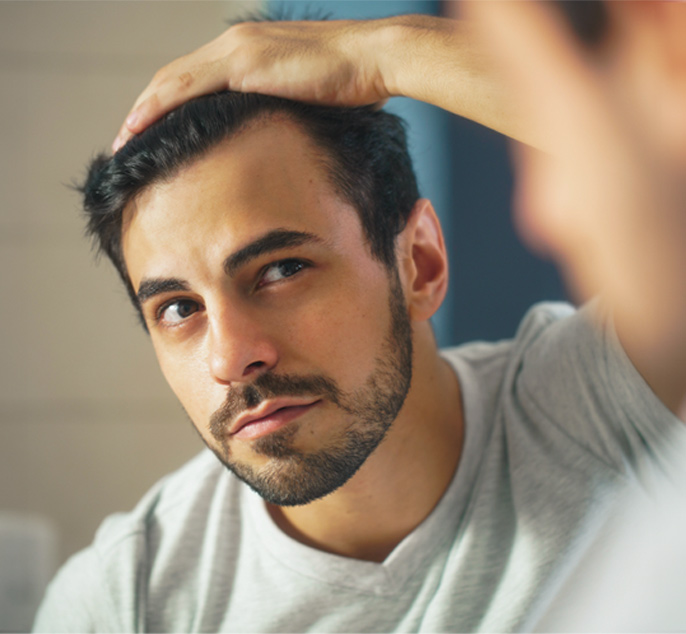

Alopecia (Hair Loss)
Types, Causes & Management OptionsThe medical term for hair loss is alopecia. A study identified that almost 58% of men between 30 and 50 years suffer from some form of alopecia. 12% of women between 20 and 29 years of age experience hair loss. Hereditary or genetic factors are the primary reasons for hair loss. With the recent advancements in trichology, doctors can now prevent balding.
Highlights
- The medical term for hair loss is alopecia.
- A study identified that almost 58% of men between 30 and 50 years suffer from some form of alopecia.
- 12% of women between 20 and 29 years of age experience hair loss.
- Hereditary or genetic factors are the primary reasons for hair loss.
- Fortunately, with the recent advancements in trichology, doctors can treat even severe cases of hair loss.
What Is Hair Loss?
Alopecia refers to hair loss that may be partial or complete, localised or generalised due to external or internal factors. Typically, we lose roughly 100 hairs a day, but if you lose more than that (around 120-150 or more) or if you see specific areas of the scalp being affected, you must consult a trichologist immediately.
Hair loss can affect any part of the body, including the scalp. The most common form of hair loss is androgenetic alopecia or patterned hair loss, and it develops gradually with time. Hair loss can affect anyone, but androgenetic alopecia is affecting people as early as in their 20s to 30s.
Types Of Hair Loss
Qualified trichologists categorise hair loss into the following types:
Androgenetic Alopecia
It is a common form of hair loss that can affect both men and women as early as during teenage with the risk increasing with age.
Telogen Effluvium
It is the most common form of diffuse hair loss that affects the scalp coverage adversely. It occurs around three months after a triggering event and is self-limiting, usually lasting for about six months.
Trichotillomania
It is a type of alopecia caused by the repeated pulling of hair. Doctors associate this type of alopecia with an impulse control disorder.
Involutional Alopecia
It is a form of hair loss that occurs because of the natural ageing process. The primary cause of this form of hair loss is the shortening of the anagen (growth) phase of the hair growth cycle. In this case, hair does not grow as fast as it sheds.
Scarring Alopecia
Also known as cicatricial alopecia, is a rare condition caused when inflammation or scarring due to various diseases hampers the scalp’s natural ability to grow hair.
Causes of Hair Loss
Several factors can trigger hair loss, including the following:
-
Poor lifestyle
Stress, improper diet, nutritional deficiencies, and poor lifestyle habits can cause hair loss.
-
Medication
Use of chemotherapy to treat cancer leads to hair loss as a side effect.
-
Tight hairstyles and chemical treatments
High-tension hairstyles such as tight ponytails may cause traction of hair follicles and lead to hair loss. Chemical treatments with the use of bleach, colour, and dye may lead to temporary hair loss.
-
Other Causes
Crash diets, nervous hair pulling, scalp infections, and allergies to hair dyes can cause hair loss.
-
Hormonal disorders
Hormonal imbalance during pregnancy or menopause trigger hair loss in women. Also, hormonal shifts due to the use of birth control pills, childbirth and hysterectomy can induce hair loss due to the shortening of the anagen phase. Insulin resistance can also result in hair loss. Men also suffer from hair loss due to hormonal imbalance.
-
Heredity
A family history of androgenetic alopecia can lead to bald patches or receding hairlines in men and thinning hair at the parting in women.
-
Health Conditions
Chronic illnesses (thyroid disorders, lupus, PCOD) and conditions like seborrheic dermatitis or psoriasis can trigger acute hair loss.
Symptoms and Types
Qualified trichologists categories hair loss into the following types:
Acute Hair Loss
Excessive and consistent hair loss exceeding 50-100 hair strands per day.
Volume Loss
Thinning of hair from the crown area.
Increased Scalp Visibility
The appearance of bald patches that are usually circular.
Chronic Scalp Conditions
Sudden loss of hair due to fungal scalp infection accompanied by pain or itching.
Reduced Hair Growth
It is a form of hair loss that occurs because of the natural ageing process. The primary cause of this form of hair loss is the shortening of the anagen (growth) phase of the hair growth cycle. In this case, hair does not grow as fast as it sheds.
Change In Hairline
A receding hairline in the form of the letter M.
Diagnosis
Untreated acne may become severe, cause permanent collagen damage and leave behind visible scars on the skin.
Consultation
A dermatologist will perform a detailed analysis of your medical history, the chronicity and severity of hair loss, health status, dietary and lifestyle habits, recent illnesses, and stressful events.
Trichoscopy
Our qualified trichologists perform trichoscopy using a specialised tool to assess scalp condition, hair quality, and hair loss severity.
Medical Investigation
Doctors may recommend blood tests to check for nutritional deficiencies and hormonal changes.
Are you at Risk?
-
Usually, men with a family history of baldness are likely to suffer from the same.
-
Women who are experiencing hormonal imbalances due to pregnancy, menopause, use of birth control pills or PCOD are also susceptible to having acute hair loss.
Prevention and Management
Avoid Harsh Chemicals and Heat
Healthy Hair Care Routine
Balanced Diet
Healthy Lifestyle
Gentle Hairstyles
Treatment Options
Treatments Explained
Prognosis
One may reverse hair loss when caused by an underlying medical condition.
- Early treatment can improve outcomes.
- Management depends on the underlying cause.
- Chronic conditions require ongoing treatment.


